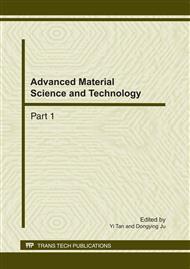[1]
K. Arafune, E. Ohishi, H. Sai, Y. Ohshita and M. Yamaguchi: J. Cryst Growth, Vol. 308 (2007), p.5.
Google Scholar
[2]
A. A. Istratov, H. Hieslmair, E. R. Weber: J. Appl. Phys. A., Vol. 70 (2000), p.489.
Google Scholar
[3]
D. R. Yang, L.B. Li and X.Y. Ma: Solar Energy Materials & Solar Cells, Vol. 62 (2000), p.37.
Google Scholar
[4]
R. Kishore, J. L Pastol and G. Revel: Solar Energy Materials., Vol. 19 (1989), p.221.
Google Scholar
[5]
Q. Sun, K. H. Yao and J. Iagowski: J. Appl. Phys. Vol. 67 (1990), p.4313.
Google Scholar
[6]
P. Fraundorf, G. K. Fraundorf and F. Shimura: J. Appl phys., Vol. 58 (1985), p.4049.
Google Scholar
[7]
H. J. Moller, C. Funke and A. Lawerenz: Solar Energy Materials & Solar Cells., Vol. 72 (2002), p.403.
Google Scholar
[8]
J. Chen, T. Sekinuehi and S. Nara: J Phys Condensed Matter, Vol. 16 (2004), p.211.
Google Scholar
[9]
Z. F. Yuan, K. Mukai: Journal of Colloid and Interface Science, Vol. 270 (2004), p.140.
Google Scholar
[10]
F. Schmid, C.P. Khattak, T.G. Digges and L. Kaufmann: J. Electrochem. Soc., (1979), pp.126-935.
Google Scholar
[11]
P.S. Ravishankar: J. Cryst. l Growth, Vol. 69 (1984), p.456.
Google Scholar
[12]
R.C. Philip, V.J. Robert and N.J. Trenton: US Patent 2, 872, 299, (1959).
Google Scholar
[13]
T.F. Ciszek: The Capillary Action Shaping Technique and its Application, (Springer-Verlag, Berlin 1981).
Google Scholar
[14]
H.J. Moller, C. Funke, M. Rinio and S. Scholz: Thin Solid Films Vol. 487(2005), p.179.
Google Scholar
[15]
Berkman, Samuel and Duffy: US Patent 4356152, (1982).
Google Scholar
[16]
E. Paloura, K. Nauka and J. Lagowski: Appl. Phys. lett. Vol. 49 (1986), p.97.
Google Scholar
[17]
M. Liu, Y. Tan, L.S. Wen and J.Y. Li: Materials Research Innovation, in press.
Google Scholar
[18]
T. Buonassisia, A. A. Istratova , M. D. Picketta, J. -P. Rakotoniainab, O. Breitensteinb, M. A. Marcusc, S. M. Healdd, E. R. Webera: Journal of Crystal Growth Vol. 287 (2006) p.402.
Google Scholar
[19]
V. Heine, C. Cheng, R. J. Needs: Am. Ceram. Soc. Vol. 74 (1991) p.2630.
Google Scholar
[20]
J. Bauer, O. Breitenstein, J. P. Rakotoniaina: Phys. Stat. Sol. Vol. 204 (2007) p.2190.
Google Scholar
[21]
J. Bauer, O. Breitenstein, M. Becker, in: Proceedings of the Seventh NREL Workshop on Crystalline Silicon Solar Cells and Modules: Materials and Processes, USA (2007).
Google Scholar
[22]
K. S. Nahm, K. C. Kim, K. Y. Lim: Electrochem. Soc., Vol. 148 (1998), p. G132.
Google Scholar
[23]
C.V. Hari Rao, H. E. Bates, K.V. Ravi: J. Appl. Phys., Vol. 47 (1976), p.2614.
Google Scholar


